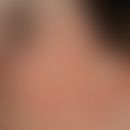Synonym(s)
DefinitionThis section has been translated automatically.
Term that summarizes the different, mostly genetically determined clinical pictures of the "atrophizing keratosis pilaris group", which are characterized by the uniform pathogenetic principle of chronic creeping follicular atrophy. The atrophizing follicular keratosis disorders are characterized by:
- follicular hyperkeratosis (friction skin)
- perifollicular and interfollicular erythema (keratosis pilaris rubra, see also erythema perstans faciei)
- follicular atrophies leading to alopecia in different hair types (vellus hair, bristly hair, long hair)
Keratosis pilaris can present itself in different degrees mono- or polytopically. It may occur in isolation or in association with atopic dermatitis or ichthyosis vulgaris.
ClassificationThis section has been translated automatically.
Keratosis pilaris syndrome includes the following clinical symptoms, which can occur in different combinations and manifest in different ways. The classification presented here is based on morphological-clinical and histological data. Valid genetic data are currently lacking.
Vellus hair follicle keratoses
- Keratosis pilaris hereditaria simplex (lichen simplex)
- Lichen spinulosus; rarer, more pronounced variant of keratosis follicularis simplex with spike-like follicular keratoses
- Keratosis pilaris atrophicans faciei (folliculitis ulerythematosa reticulata)
- Atrophodermia vermiculata (Ulerythema acneiformis)
- Erythromelanosis follicularis faciei et colli
- Keratosis follicularis spinulosa decalvans: very rare, mutations in the MBTPS2 gene.
Long hair follicular keratoses
- Ulerythema ophryogenes (keratosis pilaris rubra atrophicans)
- Frontal fibrosing (postmenopausal) alopecia (Kossard syndrome)
Remark: Long hair follicular keratoses are very frequently associated with keratosis pilaris hereditaria simplex.
You might also be interested in
HistologyThis section has been translated automatically.
The main histologic and dermoscopic findings of KP are hyperkeratosis, hypergranulosis, mild lymphocytic inflammation dominated by type 1 T helper cells, plugging of follicular openings, conspicuous absence of sebaceous glands, and hair shaft abnormalities in KP lesions but not in unaffected skin sites. Changes in barrier function and abnormal paracellular permeability can be detected in both the interfollicular and follicular stratum corneum of lesional KP, which correlated ultrastructurally with impaired maturation and organization of the extracellular lamellar bilayer. All these features were independent of the filaggrin genotype. Ultrastructurally, the corneodesmosomes and tight junctions appeared normal (Gruber R et al. 2015).
External therapyThis section has been translated automatically.
Internal therapyThis section has been translated automatically.
Acitretin (Neotigason): Start with 25 mg/day p.o. for 2-4 weeks, then dose reduction to 10 mg/day or to 5 mg/day depending on skin findings. Caveat. Contraception! In case of extensive symptoms (severe itching), low-dose glucocorticoid treatment can be combined with acitretin therapy, e.g. prednisolone (e.g. Decortin H) 20-40 mg/day with rapid gradual dose reduction.
Glucocorticoids: If possible, long-term internal therapy with glucocorticoids should be avoided because of the chronicity of the clinical picture. If necessary, short-term shock therapy at medium-high doses with rapid dose reduction. In combination with acitretin, a rapid therapeutic success can usually be observed, especially at the beginning of therapy.
Operative therapieThis section has been translated automatically.
Note(s)This section has been translated automatically.
In the literature of the past century, different terms circulate for one and the same clinical picture or for the different manifestations (keratosis pilaris, keratosis follicularis, lichen pilaris, lichen spinulosus, lichen spinulosis decalvans, etc.). To be excluded is the genodermatosis first described by Siemens, the "keratosis follicularis spinulosa decalvans". Furthermore, acquired clinical pictures characterized by follicular keratoses as e.g. the vitamin A-deficient phrynoderm.
In addition, atrophic keratosis pilaris is frequently confused with lichen planus follicularis, which also leads to follicular atrophy but is based on a fundamentally different pathogenetic principle.
LiteratureThis section has been translated automatically.
- Azambuja R et al (1987) Ulerythema ophryogenes and folliculitits ulerythemtosa reticulata. Dermatologist 38: 411-413
- Ehsani A et al (2003) Unilaterally generalized keratosis pilaris. J Eur Acad Dermatol Venereol 17: 361-362.
Gruber R et al (2015) Sebaceous gland, hair shaft, and epidermal barrier abnormalities in keratosis pilaris with and without filaggrin deficiency. Am J Pathol 185:1012-1021
Incoming links (10)
Dermatitis cruris pustulosa et atrophicans; Erythema perstans faciei; Folliculitis ulerythematosa reticulata; Frontal fibrosing alopecia; Keratosis palmoplantaris with esophageal carcinoma; Keratosis pilaris; Lichen planopilaris; MBTPS2 Gene; Noonan syndrome; Ulerythema ophryogenes;Outgoing links (20)
Acitretin; Atrophodermia vermiculata; Cryosurgery; Dermabrasion; Erythema perstans faciei; Erythromelanosis follicularis faciei et colli; Folliculitis decalvans; Folliculitis ulerythematosa reticulata; Frontal fibrosing alopecia; Glucocorticosteroids; ... Show allDisclaimer
Please ask your physician for a reliable diagnosis. This website is only meant as a reference.



























